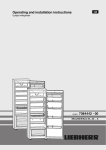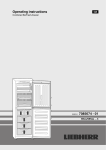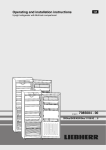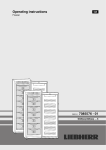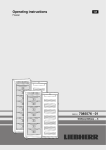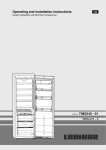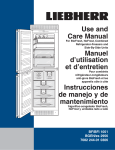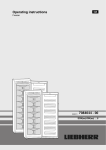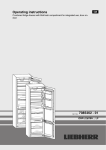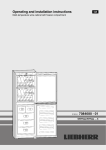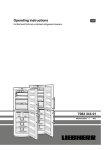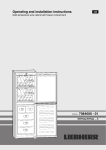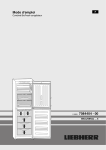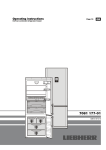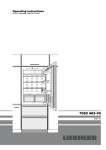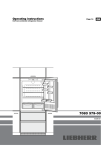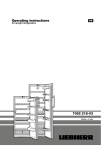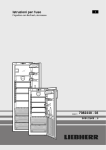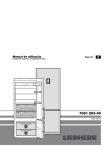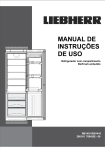Download User Manual - AGA Australia
Transcript
Operating and installation instructions Upright refrigerator 120309 7084442 - 00 SKes/Sk/K/Kes 36...42 ... 6 Appliance at a glance Contents 1 1.1 1.2 1.3 1.4 1.5 Appliance at a glance............................................ Range of appliance use............................................ Conformity................................................................ Description of appliance and equipment.................. External dimensions of the appliance....................... Net@Home............................................................... 2 2 2 2 3 3 2 General safety information................................... 3 3 3.1 3.2 Controls and displays........................................... Operating and control elements............................... Temperature display................................................. 4 4 4 4 4.1 4.2 4.3 4.4 4.5 4.6 4.7 Putting into operation............................................ Changing over the door hinges................................ Insertion into a row of kitchen units........................... Transporting the appliance....................................... Installing the appliance............................................. Disposing of packaging............................................ Connecting the appliance......................................... Switching on the appliance....................................... 4 4 5 5 5 6 6 6 5 5.1 5.2 5.3 5.4 5.5 5.6 7 7 7 7 7 7 5.7 5.8 5.9 5.10 5.11 5.12 5.13 Control.................................................................... Saving energy.......................................................... Brightness of the temperature display...................... Child proofing........................................................... Door alarm................................................................ Food refrigeration..................................................... Setting the temperature in the refrigerator compartment......................................................................... SuperCool................................................................ Fan........................................................................... Relocating the shelves............................................. Using the sectioned shelf......................................... Moving the storage rack........................................... Removing the bottle holder....................................... Vegetable bins......................................................... 6 6.1 6.2 6.3 6.4 Maintenance........................................................... 9 Cleaning the appliance............................................. 9 Changing the interior light with bulb.......................... 9 Changing the interior light with bulb.......................... 9 Customer service..................................................... 10 7 Malfunction............................................................. 10 8 8.1 8.2 Decommissioning.................................................. 11 Switching off the appliance....................................... 11 Taking the appliance out of service.......................... 11 9 Disposing of the appliance................................... 11 7 7 8 8 8 8 8 8 preparations or similar substances and products subject to the Medical Devices Directive 2007/47/EC. Any misuse of the appliance may result in damage to or spoilage of the stored goods. Furthermore, the appliance is unsuited for use in areas exposed to an explosion hazard. The appliance is set to operate within specific ambient temperature limits according to its climate rating. The correct climate rating for your appliance is indicated on the type plate. Note u Compliance with the ambient temperatures indicated is required, otherwise the cooling performance is reduced. Climate rating for ambient temperatures of SN 10 °C to 32 °C N 16 °C to 32 °C ST 16 °C to 38 °C T 16 °C to 43 °C 1.2 Conformity The refrigerant circuit has been tested for leaks. The appliance complies with current safety regulations and EC directives 2006/95/EC and 2004/108/EC. 1.3 Description of appliance and equipment The manufacturer works constantly on the further development of all the types and models. Therefore please understand that we have to reserve the right to make design, equipment and technical modifications. To get to know all the benefits of your new appliance, please read the information contained in these instructions carefully. The instructions apply to several models. Differences may occur. Text relating only to specific appliances is marked with an asterisk (*). Instructions for action are marked with a , the results of action are marked with a . 1 Appliance at a glance 1.1 Range of appliance use The appliance is suited only for cooling food. In the case of commercial food cooling, the pertinent statutory regulations have to be observed. The appliance is not suited for storing and cooling pharmaceuticals, blood plasma, laboratory 2 Fig. 1 (1) Operating panel (9) Bottle shelf General safety information (2) (3) (4) (5) Ceiling light Fan Box shelves, removable Glass shelves, relocatable (6) Door rack for tinned food, relocatable (7) Glass shelf, sectioned, relocatable (8) Door rack for bottles, relocatable (10) Defrost water channel (11) Glass shelf (12) Type plate (13) Coldest zone (14) Vegetable compartment (15) Height-adjustable foot * 1.4 External dimensions of the appliance Fig. 2 Designation H (mm) K 36 1655 K 42 1852 - In case of a fault, pull out the mains plug (not by pulling the connecting cable) or switch off the fuse. - Have any repairs to or intervention in the appliance, and any change of the mains power cable, carried out by the customer service only or by other specialised personnel trained for the purpose. - When disconnecting the appliance from the supply, always take hold of the plug. Do not pull the cable. - Install and connect the appliance only as instructed. - Please keep these instructions in a safe place and pass them on to any subsequent owners. Fire hazard: - The refrigerant R 600a is environmentally friendly but flammable. Escaping refrigerant may ignite. • Do not damage the refrigerant circuit pipes. • Do not allow naked flames or ignition sources to enter the appliance. • Do not use any electrical appliances in the interior (e.g. steam cleaners, heaters, ice cream maker etc.). • If refrigerant escapes: eliminate naked flames or sources of ignition from the vicinity. Pull out the power plug. Ventilate the area well. Notify customer service. - Do not store explosives or sprays using combustible propellants such as butane, propane, pentane, etc. in the appliance. Respective spray cans can be identified by reference to the contents printed on the can or by a flame symbol. Gases possibly escaping may ignite due to electrical components. - Do not place any burning candles, lamps or other items with naked flames on or in the appliance. - Only store high-percentage alcohol in tightly sealed, upright containers. Alcohol possibly escaping may ignite due to electrical components. Danger of tipping and falling: - Do not misuse the plinth, drawers, doors etc. as a step or for support. This applies particularly to children. Danger of food poisoning: - Do not consume food which has been stored too long. Danger of frostbite, numbness and pain: - Avoid lasting skin contact with cold surfaces or refrigerated/ frozen food or take protective steps, e.g. wear gloves. Do not consume ice cream, water ice or ice cubes immediately and do not consume them too cold. Please observe the specific information in the other sections: DANGER identifies a situation involving direct danger which, if not obviated, may result in death or severe bodily injury. The appliance can be provided with the retrofit modules for the HomeDialog system or the serial interface (RS 232), depending on model and equipment. The modules are available from your specialist dealer. You will find more information on the internet at www.liebherr.com. WARNING identifies a dangerous situation which, if not obviated, may result in death or severe bodily injury. CAUTION identifies a dangerous situation which, if not obviated, may result in minor or medium bodily injury. NOTICE identifies a dangerous situation which, if not obviated, may result in damage to property. 2 General safety information Note identifies useful information and tips. 1.5 Net@Home Danger for the user: - This appliance is not designed for persons (including children) with physical, sensory or mental impairment or persons not having sufficient experience and knowledge, unless they are instructed in the use of the appliance and are initially supervised by a person responsible for their safety. Keep children under supervision to ensure they do not play with the appliance. 3 Controls and displays 3 Controls and displays 3.1 Operating and control elements (1) (2) (3) (4) (5) (6) (7) Alarm button SuperCool button On/Off button Alarm symbol Menu symbol Down setting button Up setting button Fig. 3 (8) Fan button (9) Temperature display (10) Fan symbol (11) Child-proofing symbol (12) SuperCool symbol (13) Net@Home symbol 3.2 Temperature display The following are displayed in normal operation: - the average cooling temperature The following displays indicate malfunction. Possible causes and corrective action (see Malfunction). - F0 to F9 4 Putting into operation Fig. 4 u Close the door. u Pull off the cover Fig. 4 (10) forwards and upwards. u Lift off the cover Fig. 4 (11). CAUTION Risk of injury if the door tips! u Take good hold of the door. u Set down the door carefully. u Unscrew the upper turn hinge Fig. 4 (12)(2 Torx 25) Fig. 4 (13) and raise it for removal. u Lift up the door and set it aside. 4.1.2 Changing bearing parts 4.1 Changing over the door hinges You can change over the door hinges if necessary. NOTICE Risk of damage to side-by-side appliances due to condensation! When a Side-by-Side appliance (S…) is fitted together with a second appliance (as a SBS combination), the door hinges must remain as delivered. u Do not change over the door hinges. Ensure that the following tools are to hand: q Torx 25 q Torx 15 q Screwdriver q Cordless screwdriver, if necessary q Second person for fitting work, if needed 4.1.1 Detaching the door Note u Remove any food from the door racks before removing the door, so that no food falls out. u u u u u u u u u Fig. 5 Draw the safety lock Fig. 5 (21) forwards for removal. Remove the cover Fig. 5 (27).* Fully retract the adjustable-height foot Fig. 5 (22). If necessary, tip the appliance back a little with the assistance of a second person for removal of the bearing pin. Pull out the bearing pin Fig. 5 (22) downwards and forwards. In so doing, pay attention to the hinge bush Fig. 5 (20). Unscrew the turn hinge Fig. 5 (23)(2 Torx 25) Fig. 5 (24). Unscrew the bearing part Fig. 5 (26)(1 Torx 25), Fig. 5 (28), transfer it to the opposite hole in the turn hinge and screw it down again. Carefully lift off and transfer the cover Fig. 5 (25) on the handle side. Screw down the turn hinge Fig. 5 (23) on the new hinge side, possibly with the aid of a cordless screwdriver, through the outer oblong hole and round hole. Note u If necessary, e.g. to make up for any unevenness in the floor, the second oblong hole can be used instead of the round hole for the screw fitting. 4 Putting into operation u Tip the appliance back a little again and re-insert the bearing pin Fig. 6 (22). The notch has to point forwards. u Place the cover Fig. 5 (27) on the opposite side.* 4.1.5 Aligning the door u Transfer the middle screw on the lower turn hinge Fig. 5 (23) into the free oblong hole. u Align the door to the appliance housing by way of the two oblong holes in the lower turn hinge Fig. 5 (23). u Tighten the screws. 4.2 Insertion into a row of kitchen units Fig. 6 CAUTION Risk of injury if the door tips! u The safety lock (21) has to engage with the turn hinge at the side so that the bearing pin and therefore the door are secured. u u Snap the safety lock (21) onto the turn hinge again. u Put on the hinge bush Fig. 5 (20). 4.1.3 Transferring the handle u Disengage the spring clip Fig. 7 (34) from the door and transfer it to the new hinge side. u Lift the stopper Fig. 7 (30) out of the door bearing bush and transfer it. Fig. 7 u Detach door handle Fig. 7 (31), stoppers Fig. 7 (32) and pressure plates Fig. 7 (33) plates and transfer to the opposite side u When fitting the pressure plates at the opposite side, pay attention that they engage properly. 4.1.4 Fitting the lower door u Place the door from above onto the lower bearing pin Fig. 5 (22). u Close the door. u Insert the upper turn hinge Fig. 4 (12) in the door on the new hinge side. u Screw down the upper turn hinge Fig. 4 (12)(2 Torx 25) Fig. 4 (13). Possibly make preliminary holes with a bradawl or use a cordless screwdriver. u Snap the cover Fig. 4 (10) and cover Fig. 4 (11) into place at the opposite side. Fig. 8 (1) Stack cabinet (3) Kitchen cabinet (2) Appliance (4) Wall The appliance can be inserted into a row of kitchen units. To match the appliance Fig. 8 (2) to the height of the row of units, a suitable stack cabinet Fig. 8 (1) can be fitted above the appliance. When inserting the appliance into a row of standard kitchen units (max. depth 580 mm), the appliance can be installed directly next to the kitchen unit Fig. 8 (3). The appliance door projects relative to the front of the kitchen unit by 34 mm at the side and by 50 mm in the middle of the appliance. It can be opened and closed perfectly as a result. Important for the ventilation: - At the back of the stack cabinet there has to be a ventilation duct of at least 50 mm depth throughout the width of the stack cabinet. - The ventilation space under the ceiling has to be at least 300 cm2. - The larger the ventilation space, the more energy-saving the appliance is in operation. If the appliance is installed with the hinges next to a wall Fig. 8 (4), the distance between appliance and wall has to be at least 36 mm. This corresponds to the projection of the handle when the door is open. 4.3 Transporting the appliance CAUTION Risk of injury and danger of damage as a result of incorrect transport! u Transport the appliance in a packed condition. u Transport the appliance upright. u Do not transport the appliance without assistance. 4.4 Installing the appliance In the event that the appliance is damaged, contact the supplier immediately before connecting to the mains. The floor at the site must be flat and level. Do not install the appliance in a location where it is exposed to direct radiation of the sun, next to a cooker, heater and similar. 5 Putting into operation Always install the appliance directly against the wall. Do not install the appliance without assistance. Standard EN 378 specifies that the room in which you install your appliance must have a volume of 1 m 2 per 8 g of R 600a refrigerant used in the appliance. If the room in which the appliance is installed is too small, a flammable gas-air mixture may form in the event of a leakage in the refrigeration circuit. The quantity of refrigerant used in your appliance is indicated on the type plate on the inside of the appliance. WARNING Fire hazard due to dampness! If live parts or the mains lead become damp this may cause short circuits. u The appliance is designed for use in enclosed areas. Do not operate the appliance outdoors or in areas where it is exposed to splash water or damp conditions. WARNING Fire hazard due to refrigerant! The refrigerant R 600a is environmentally friendly but flammable. Escaping refrigerant may ignite. u Do not damage the piping of the refrigeration circuit. WARNING Fire hazard and danger of damage! u Do not place appliances emitting heat e.g. microwaves, toasters etc. on the appliance! WARNING Fire hazard and risk of damage due to blocked ventilation grille! u Always keep the ventilation grille free. Always ensure that the appliance is properly ventilated. u Detach the connecting cable from the rear of the appliance, removing the cable holder at the same time because otherwise there will be vibratory noise! u Remove the protective film from the outside of the appliance. u Evenly apply an agent for care of stainless steel, wiping in the direction of the grain. w Subsequent cleaning becomes easier as a result. NOTICE The stainless steel doors have a high-quality surface coating and must not be cleaned with the accompanying care product. Otherwise the surface coating will be affected. u Wipe the coated door surfaces using a soft, clean cloth only. u Apply a stainless steel cleaner only to the stainless steel side walls evenly, wiping with the grain. Subsequent cleaning becomes easier as a result. u Remove all transit supports. u Dispose of packaging material (see 4.5) . u Align the appliance so that it stands firmly and on a level by applying the accompanying spanner to the adjustable-height feet (A) and using a spirit level. u Then support the door: Extend the adjustable foot at the turn hinge (B) until it rests on the floor and then make a further 90° turn. When a Side-by-Side appliance (S…) is fitted together with a second appliance (as a SBS combination): u Proceed according to the Side-by-Side combined fridgefreezer installation instructions. (Accessories bag of the SBS freezer/appliance with freezer compartment) If the appliance is installed in a very damp environment, condensate may form on the outside of the appliance.* u Always see to good ventilation at the installation site. 4.5 Disposing of packaging WARNING Danger of suffocation due to packing material and plastic film! u Do not allow children to play with packing material. The packaging is made of recyclable materials: - corrugated board/cardboard - EPS moulded parts - polythene bags and sheets - polypropylene straps u Take the packaging material to an official collecting point. 4.6 Connecting the appliance NOTICE Risk of damage to the electronic control system! u Do not use stand-alone inverters (conversion of d.c. to a.c./ three-phase) or energy saving plugs. WARNING Fire and overheating hazard! u Do not use extension cables or multiple socket outlets. The type of current (alternating current) and voltage at the installation site have to conform with the data on the type plate (see Appliance at a glance). Connect the appliance only with a properly installed socket outlet with earthing contact. The socket outlet must be fused with 10 A or higher. It must be easily accessible so that the appliance can be quickly disconnected from the supply in an emergency. u Check the electrical connection. u Clean the appliance (see 6.1) . u Plug in the power plug. 4.7 Switching on the appliance u Press On/Off button Fig. 3 (3). w The temperature display indicates the current temperature. w The interior light is on when the door is open. 6 Control 5 Control 5.1 Saving energy u Always pay attention to good ventilation. u Keep the time the appliance is open to a minimum. u Store food logically. u First cool warm food to room temperature before storing it . Accumulated dust increases the energy consumption: u Once a year, dust the refrigerating unit together with the metal grille of the heat exchanger at the back of the appliance. 5.2 Brightness of the temperature display 5.2 NOT APPLICABLE IN AUSTRALIA You can adjust the brightness of the temperature display to the light conditions of the room in which the appliance is installed. 5.2.1 Adjusting the brightness The brightness is adjustable between h0 (no illumination) and h5 (maximum luminosity). u To activate the setting mode: press SuperCool button Fig. 3 (2) for about 5s. w The display indicates c. w The menu symbol Fig. 3 (5) shines. u Using the Up setting button Fig. 3 (7) and Down setting button Fig. 3 (6), select h. u To confirm: briefly press the SuperCool button Fig. 3 (2). u To set the display brighter: press the Up setting button Fig. 3 (7). u To set the display darker: press the Down setting button Fig. 3 (6). u To confirm: briefly press the SuperCool button Fig. 3 (2). w The brightness is adjusted to the new value. u To deactivate the setting mode: press the On/Off button Fig. 3 (3). -oru Wait for 5 minutes. w The temperature is indicated again in the temperature display. 5.3 Child proofing The child-proofing function enables you to make sure that the appliance is not inadvertently switched off by playing children. 5.3.1 Setting the child lock function u To activate the setting mode: press SuperCool button Fig. 3 (2) for about 5 s. w The display indicates c. w The menu symbol Fig. 3 (5) shines. u Briefly press theSuperCool button Fig. 3 (2) to confirm. When c1 is indicated in the display: u to activate the child lock, briefly press the SuperCool button Fig. 3 (2). w The child lock symbol Fig. 3 (11) goes out. c flashes in the display. u To deactivate the set-up mode: press On/Off button Fig. 3 (3). -oru Wait for 5 minutes. w The temperature is indicated again in the temperature display. 5.4 Door alarm If the door is open longer then 60 s, the audible alarm sounds. The audible alarm is automatically silenced when the door is closed. 5.4.1 Muting the door alarm The audible alarm can be muted when the door is open. The sound switch-off function is active as long as the door is left open. u Press alarm button Fig. 3 (1). w The door alarm is silenced. 5.5 Food refrigeration Note The energy consumption increases and the cooling performance decreases if the ventilation is inadequate. u Always keep the air slits of the fan free. u Store perishable food such as ready-to-serve dishes, meat products and sausages in the coldest zone. Place butter, eggs and preserves in the upper area and in the door (see Appliance at a glance). u Use recyclable plastic, metal, aluminium and glass containers and cling film for wrapping. u Use the front area of the refrigerator compartment floor only for briefly putting down cooled products, e.g. when rearranging and sorting. However do not leave cooled products there otherwise they may be pushed back or tipped over when the door is closed. u Do not store food too close together to enable good air circulation. u To safeguard bottles from tipping over: move the bottle holder. 5.6 Setting the temperature in the refrigerator compartment The temperature can be set from 9 °C to 2 °C, the recommended temperature is 5 °C. u For a higher temperature setting: press Up button Fig. 3 (7). u For a lower temperature setting: press Down button Fig. 3 (6). w The first time the button is pressed, the value set so far is indicated in the temperature display. u To change the temperature in 1 °C steps: briefly press the button. u To change the temperature continuously: hold down the button. w The value is displayed flashing during the setting operation. w The actual temperature is displayed about 5 s after the last press of a button. The temperature slowly adjusts to the new value. 5.7 SuperCool w The child lock symbol Fig. 3 (11) shines. c flashes in the display. When c0 is indicated in the display: u to deactivate the child lock, briefly press the SuperCool button Fig. 3 (2). With SuperCool you switch to the highest cooling performance to reach lower cooling temperatures. Use SuperCool, to rapidly cool large amounts of food. The SuperCool function uses slightly more energy. 7 Control 5.7.1 Cooling with SuperCool u Briefly press SuperCool button Fig. 3 (2). w The SuperCool symbol Fig. 3 (12) lights up in the display. w The cooling temperature drops to the coldest value. SuperCool is activated. w SuperCool is automatically deactivated after 6 to12 hours The appliance continues to operate in the energy-saving, normal mode. 5.11 Moving the storage rack u Remove storage rack according to illustration. 5.7.2 To prematurely deactivate SuperCool u Briefly press SuperCool button Fig. 3 (2). w The SuperCool symbol Fig. 3 (12) goes out in the display. w SuperCool is deactivated. 5.8 Fan With the fan you can rapidly cool large quantities of fresh food or achieve a relatively even distribution of temperature across all the storage levels. The forced-air cooling is to be recommended: - at high room temperature (from approx. 30 °C ) - at high humidity The forced-air cooling uses slightly more energy. To save energy, the fan switches off automatically when the door is open. The boxes can be removed and placed on the table as a single unit. Only one box or both boxes can be used. If particularly tall bottles are to be stored, attach only the wide box above the bottle rack. Three small boxes are available through the customer service as optional equipment instead of one wide and one small box. u Re-positioning the boxes: Lift them for removal and re-position them as required. u To detach lid: Open 90° and raise to disengage. 5.8.1 Switching on the fan u Briefly press the fan button Fig. 3 (8). w The fan symbol Fig. 3 (10) shines. w The fan is active. It switches on automatically when the compressor runs. 5.8.2 To switch off the fan 5.12 Removing the bottle holder u Always take hold of the bottle holder on the plastic part. u Briefly press the fan button Fig. 3 (8). w The fan symbol Fig. 3 (10) goes out. w The fan is switched off. 5.9 Relocating the shelves The shelves have stops preventing them from being unintentionally pulled out. u Lift the shelf and draw it out forwards. 5.13 Vegetable bins Fig. 10 u Insert shelf with the raised edge pointing upwards at the back. w The food does not freeze onto the rear wall. 5.10 Using the sectioned shelf To remove the vegetable bins: u pull the vegetable bin all the way out and tilt it forwards a little. w In the case of the bottom drawer, the drawer locking device is additionally released and the vegetable bin can be removed. u Push the projecting telescopic slides back in. Fig. 11 Fig. 9 u The glass shelf with stop face (2) has to be at the back. 8 To insert the vegetable bins: u place the vegetable bin on the telescopic slides and push to the rear, exerting slight pressure. w In the case of the bottom drawer, the drawer locking device additionally engages and the vegetable drawer sits firmly on the telescopic slides. Maintenance 6 Maintenance 6.1 Cleaning the appliance. Before cleaning: CAUTION Risk of injury and damage as a result of hot steam! Hot steam may damage the surfaces and cause burns. u Do not use any steam cleaners! NOTICE Incorrect cleaning damages the appliance! u Do not use cleaning agents in concentrated form. u Do not use any scouring or abrasive sponges or steel wool. u Do not use any cleaning agents containing sand, chloride, chemicals or acid. u Do not use chemical solvents. u Do not damage or remove the type plate on the inside of the appliance. It is important for the customer service. u Do not pull off, bend or damage cables or other components. u Do not allow any cleaning water to enter the drain channel, ventilation grille or electrical parts. u Empty the appliance. u Pull out the plug. - Use soft cleaning cloths and a multi-purpose cleaning agent with neutral pH value. - Only use food compatible cleaning and care agents on the inside of the appliance. Outside surfaces and interior: u Regularly clean ventilation grilles. w Dust deposits increase energy consumption. u Clean the plastic surfaces, outside and inside, by hand using lukewarm water and a little washing-up liquid. NOTICE The stainless steel doors have a high-quality surface coating and must not be cleaned with the accompanying care product. Otherwise the surface coating will be affected. u Wipe the coated door surfaces using a soft, clean cloth only. In case of stubborn dirt, use a little water or a neutral cleaning agent. A microfibre cloth can be optionally used. u If the stainless steel side walls are dirty, clean them using a commercially available stainless steel cleaning agent. Then evenly apply the accompanying stainless steel care product, making strokes in the direction of the grain. u Wipe side walls with a paint finish using a soft, clean cloth only. In case of stubborn dirt, use a little water or a neutral cleaning agent. A microfibre cloth can be optionally used. Clean stainless steel surfaces with a standard stainless steel cleaning agent. Darker areas at the beginning and quite an intensive colour of the stainless steel surface are normal. u Do not apply cleaners to glass or plastic surfaces so as not to scratch them. u To clean stainless steel surfaces: evenly apply an agent for care of stainless steel, wiping in the direction of the grain. u To clean the drain opening: remove any deposits with a fine instrument, e.g. a cotton bud. Items of equipment: u Clean items of equipment by hand with lukewarm water and a little washing-up liquid. u To dismantle the shelves: remove the trims and side parts. u To dismantle the storage rack: remove the protective film from the decorative trims. u Lift out the boxes and lift the covers for removal. After cleaning: u Wipe dry the appliance and items of equipment. u Connect the appliance and switch it on again. u Put the food back inside. 6.2 Changing the interior light with bulb Bulb data max. 25 W Fitting: E14 Type of current and voltage must conform with the details on the type plate u Switch off the appliance. u Pull out the power plug or switch off the fuse. u Take holder of the cover Fig. 12 (1) at the front and unhook it at the back. u Change the bulb Fig. 12 (2). u Put the cover Fig. 12 (1) back in place. Fig. 12 6.3 Changing the interior light with bulb Bulb data T25 tube, Philips max. 25 W Fitting: E14 Type of current and voltage must conform with the details on the type plate Fig. 13 u Switch off the appliance. u Pull out the power plug or switch off the fuse. u To remove the cover Fig. 13 (1): put your finger behind the cover and disengage it. u Pull out the glass shelf Fig. 13 (2). u Change the bulb Fig. 13 (3). u Slide the glass shelf back in. u Attach the cover again, engage it at the right and left and pay attention that the middle hook Fig. 13 (4) grips over the glass shelf. 9 Malfunction 6.4 Customer service First check whether you can correct the fault yourself by reference to the list (see Malfunction). If this is not the case, please contact the customer service whose address is given in the enclosed customer service list. WARNING Risk of injury if repair work is not carried out professionally! u Have any repairs to and intervention in the appliance and mains power cable, which are not expressly mentioned in the (see Maintenance) carried out by the customer service only. u Read the appliance designation Fig. 14 (1), service No. Fig. 14 (2) and serial No. Fig. 14 (3) off the type plate located inside the appliance on the lefthand side. Fig. 14 u Notify the customer service, specifying the fault, appliance designation Fig. 14 (1), service No. Fig. 14 (2) and serial No. Fig. 14 (3). w This will help us to provide you with a faster and more accurate service. u Keep the appliance closed until the customer service arrives. w The food will stay cool longer. u Pull out the mains plug (not by pulling the connecting cable) or switch off the fuse. 7 Malfunction Your appliance is designed and manufactured for a long life span and reliable operation. If a malfunction nonetheless occurs during operation, check whether it is due to a handling error. In this case you will have to be charged for the costs incurred, even during the warranty period. You may be able to rectify the following faults yourself: Appliance does not work. → The appliance is not switched on. u Switch on the appliance. → The power plug is not properly inserted in the wall socket. u Check power plug. → The fuse of the wall socket is not in order. u Check fuse. The compressor runs for a long time. → The compressor switches to a low speed when little cold is needed. Although the running time is increased as a result, energy is saved. u This is normal in energy-saving models. → SuperCool is activated. u The compressor runs for longer in order to rapidly cool the food. This is normal. A bubbling and gurgling noise → This noise comes from the refrigerant flowing in the refrigeration circuit. u The sound is normal. A quiet clicking noise → The noise is produced whenever the refrigeration unit (motor) automatically switches on or off. u The sound is normal. 10 A hum. It is briefly a little louder when the refrigeration unit (the motor) switches on. → The refrigeration increases automatically when the SuperCool function is activated, fresh food has just been placed in the appliance or the door has been left open for a while. u The sound is normal. → The ambient temperature is too high. u Solution: (see 1.1) A low hum → The sound is produced by air flow noise of the fan. u The sound is normal. Vibratory noise → The appliance is not standing firmly on the floor. As a result, adjoining units or objects are set into vibration by the running refrigeration unit. u Move the appliance away a little and align it using the adjustable feet. u Move bottles and containers apart. The temperature display indicates: F0 to F9 → There is a fault. u Contact the customer service (see Maintenance). DEMO shines in the temperature display. → The demo mode is activated. u Contact the customer service (see Maintenance). The temperature is not cold enough. → The door of the appliance is not properly closed. u Close the door of the appliance. → Insufficient ventilation. u Clear ventilation grilles. → The ambient temperature is too high. u Solution: (see 1.1) . → The appliance was opened too frequently or for too long. u Wait until the appliance reaches the required temperature itself. If not, contact the customer service. (see Maintenance). → The temperature is incorrectly set. u Set to a colder temperature and check after 24 h. → The appliance is too close to a heat source. u Solution: (see Putting into operation). The interior light is not on. → The appliance is not switched on. u Switch on the appliance. → The door was open longer than 15 min. u The interior light automatically switches off if the door has been open for about 15 min. → If the interior light is not on but the temperature display is lit, the bulb is faulty.* u Change the bulb: (see Maintenance)* → The LED interior lighting is faulty or the cover is damaged:* WARNING* Risk of injury due to electric shock! Live parts are located under the cover. u Have the LED interior light changed or repaired only by the customer service or by specialized personnel trained for the purpose. WARNING* Danger of injury due to laser radiation, class 1M. u Do not look inside when the cover is open. Decommissioning 8 Decommissioning 8.1 Switching off the appliance u Press On/Off button Fig. 3 (3) for about 2 s. w The temperature display is dark. 8.2 Taking the appliance out of service u Empty the appliance. u Pull out the power plug. u Clean the appliance (see 6.1) . u Leave the door open to prevent odour. 9 Disposing of the appliance The appliance contains some reusable materials and should be disposed of properly - not simply with unsorted household refuse. Appliances which are no longer needed must be disposed of in a professional and appropriate way, in accordance with the current local regulations and laws. When disposing of the appliance, ensure that the refrigeration circuit is not damaged to prevent uncontrolled escape of the refrigerant it contains (data on type plate) and oil. u Disable the appliance. u Pull out the plug. u Cut through the connecting cable. 11 Disposing of the appliance 12 Operating instructions Combined BioFresh-freezer 110309 7084404 - 00 BNes/SBNes ... 6 Appliance at a glance Contents 1 1.1 1.2 1.3 1.4 1.5 Appliance at a glance............................................ Range of appliance use............................................ Conformity................................................................ Description of appliance and equipment.................. External dimensions of the appliance....................... Net@Home............................................................... 2 2 2 2 3 3 2 General safety information................................... 3 3 3.1 3.2 Controls and displays........................................... Operating and control elements............................... Temperature display................................................. 4 4.1 4.2 4.3 4.4 4.5 4.6 4.7 4.8 Putting into operation............................................ Changing over the door hinges................................ Water connection..................................................... Insertion into a row of kitchen units........................... Transporting the appliance....................................... Installing the appliance............................................. Disposing of packaging............................................ Connecting the appliance......................................... Switching on the appliance....................................... 5 5.1 5.2 5.3 5.4 5.5 5.6 5.7 Control.................................................................... 7 Saving energy.......................................................... 7 Brightness of the temperature display...................... 8 Child proofing........................................................... 8 Door alarm................................................................ 8 Temperature alarm................................................... 8 BioFresh compartment............................................. 8 Freezer compartment............................................... 10 6 6.1 6.2 6.3 6.4 Maintenance........................................................... Defrosting with NoFrost............................................ Cleaning the appliance............................................. Cleaning the IceMaker............................................. Customer service..................................................... 7 Malfunction............................................................. 13 8 8.1 8.2 Decommissioning.................................................. 14 Switching off the appliance....................................... 14 Taking the appliance out of service.......................... 14 9 Disposing of the appliance................................... 14 The appliance is set to operate within specific ambient temperature limits according to its climate rating. The correct climate rating for your appliance is indicated on the type plate. Note u Compliance with the ambient temperatures indicated is required, otherwise the cooling performance is reduced. Climate rating for ambient temperatures of 3 3 4 SN 10 °C to 32 °C N 16 °C to 32 °C 4 4 5 6 6 6 7 7 7 ST 16 °C to 38 °C T 16 °C to 43 °C 1.2 Conformity The refrigerant circuit has been tested for leaks. The appliance complies with current safety regulations and EC directives 2006/95/EC and 2004/108/EC. 1.3 Description of appliance and equipment 12 12 12 12 13 The manufacturer works constantly on the further development of all the types and models. Therefore please understand that we have to reserve the right to make design, equipment and technical modifications. To get to know all the benefits of your new appliance, please read the information contained in these instructions carefully. The instructions apply to several models. Differences may occur. Text relating only to specific appliances is marked with an asterisk (*). Instructions for action are marked with a , the results of action are marked with a . 1 Appliance at a glance 1.1 Range of appliance use The appliance is suited only for cooling food. In the case of commercial food cooling, the pertinent statutory regulations have to be observed. The appliance is not suited for storing and cooling pharmaceuticals, blood plasma, laboratory preparations or similar substances and products subject to the Medical Devices Directive 2007/47/EC. Any misuse of the appliance may result in damage to or spoilage of the stored goods. Furthermore, the appliance is unsuited for use in areas exposed to an explosion hazard.* 2 (1) Transport grips at back (2) Operating and control elements (3) Interior light (4) Bottle shelf (5) Shelf, sectioned (6) Shelf (7) Storage zone with relatively dry climate (10) Drain hole (11) IceMaker Fig. 1 (12) Cold storage accumulator (13) Freezer tray (14) VarioSpace (15) Information system (16) Drawers General safety information (8) BioFresh controller (9) HydroSafe (17) Type plate (18) Adjustable feet, transport grips at front, transport castors at back 1.4 External dimensions of the appliance Fig. 2 1.5 Net@Home The appliance can be provided with the retrofit modules for the HomeDialog system or the serial interface (RS 232), depending on model and equipment. The modules are available from your specialist dealer. You will find more information on the internet at www.liebherr.com. • Do not allow naked flames or ignition sources to enter the appliance. • Do not use any electrical appliances in the interior (e.g. steam cleaners, heaters, ice cream maker etc.). • If refrigerant escapes: eliminate naked flames or sources of ignition from the vicinity. Pull out the power plug. Ventilate the area well. Notify customer service. - Do not store explosives or sprays using combustible propellants such as butane, propane, pentane, etc. in the appliance. Respective spray cans can be identified by reference to the contents printed on the can or by a flame symbol. Gases possibly escaping may ignite due to electrical components. - Do not place any burning candles, lamps or other items with naked flames on or in the appliance. - Only store high-percentage alcohol in tightly sealed, upright containers. Alcohol possibly escaping may ignite due to electrical components. Danger of tipping and falling: - Do not misuse the plinth, drawers, doors etc. as a step or for support. This applies particularly to children. Danger of food poisoning: - Do not consume food which has been stored too long. Danger of frostbite, numbness and pain: - Avoid lasting skin contact with cold surfaces or refrigerated/ frozen food or take protective steps, e.g. wear gloves. Do not consume ice cream, water ice or ice cubes immediately and do not consume them too cold. Please observe the specific information in the other sections: DANGER identifies a situation involving direct danger which, if not obviated, may result in death or severe bodily injury. WARNING identifies a dangerous situation which, if not obviated, may result in death or severe bodily injury. CAUTION identifies a dangerous situation which, if not obviated, may result in minor or medium bodily injury. NOTICE identifies a dangerous situation which, if not obviated, may result in damage to property. Note identifies useful information and tips. 2 General safety information Danger for the user: - This appliance is not designed for persons (including children) with physical, sensory or mental impairment or persons not having sufficient experience and knowledge, unless they are instructed in the use of the appliance and are initially supervised by a person responsible for their safety. Keep children under supervision to ensure they do not play with the appliance. - In case of a fault, pull out the mains plug (not by pulling the connecting cable) or switch off the fuse. - Have any repairs to or intervention in the appliance, and any change of the mains power cable, carried out by the customer service only or by other specialised personnel trained for the purpose. - When disconnecting the appliance from the supply, always take hold of the plug. Do not pull the cable. - Install and connect the appliance only as instructed. - Please keep these instructions in a safe place and pass them on to any subsequent owners. - All repairs to and intervention in the IceMaker may be carried out only by service personnel or by other skilled personnel trained for the purpose. - The manufacturer is not liable for damage caused by a faulty fixed water connection. Fire hazard: - The refrigerant R 600a is environmentally friendly but flammable. Escaping refrigerant may ignite. • Do not damage the refrigerant circuit pipes. 3 Controls and displays 3.1 Operating and control elements Fig. 3 (1) BioCool button (2) On/Off button, BioFresh compartment (3) Up setting button, BioFresh compartment (4) Down setting button, BioFresh compartment (5) Power failure symbol (6) BioFresh compartment temperature display (11) SuperFrost button (12) Alarm button (13) BioCool symbol (14) Child-proofing symbol (15) Menu symbol (16) Net@Home symbol 3 Putting into operation (7) Alarm symbol (8) Up setting button, freezer compartment (9) Down setting button, freezer compartment (10) On/Off button, freezer compartment (17) Freezer compartment temperature display (18) SuperFrost symbol (19) IceMaker symbol 3.2 Temperature display - the warmest freezing temperature - the average BioFresh temperature The freezer compartment temperature display flashes: - the temperature setting is being changed - after switch-on the temperature is not yet cold enough - the temperature has risen several degrees The following displays indicate malfunction. Possible causes and corrective action (see Malfunction). - F0 to F9 - FE - The power failure symbol shines. u Lift off the cover Fig. 4 (2) CAUTION Risk of injury if the door tips! u Take good hold of the door. u Set down the door carefully. u Unscrew the upper turn hinge Fig. 4 (3)(2 Torx 25) Fig. 4 (4) and raise it for removal. u Lift up the upper door and set it aside. 4.1.2 Detaching the lower door u Close the lower door. u Draw the middle bearing pin Fig. 5 (11) out of the turn hinge and lower door. u Remove the plastic cap Fig. 5 (10). CAUTION Risk of injury if the door tips! u Take good hold of the door. u Set down the door carefully. 4 Putting into operation u Open the lower door. u Detach the middle turn hinge Fig. 5 (13). u Lift up the door and set it aside. 4.1 Changing over the door hinges 4.1.3 Transferring the middle bearing elements You can change over the door hinges if necessary. NOTICE Risk of damage to side-by-side appliances due to condensation! When a Side-by-Side appliance (S…) is fitted together with a second appliance (as a SBS combination), the door hinges must remain as delivered. u Do not change over the door hinges. Ensure that the following tools are to hand: q Torx 25 q Torx 15 q Screwdriver q Cordless screwdriver, if necessary q Second person for fitting work, if needed 4.1.1 Detaching the upper door Note u Remove any food from the door racks before removing the door, so that no food falls out. Fig. 4 u Close the upper door. u Pull off the cover Fig. 4 (1) forwards and upwards. 4 Fig. 5 u Carefully detach the cover panel Fig. 5 (12). u Turn the middle turn hinge Fig. 5 (13) 180° and transfer it to the new hinge side. u Turn the cover panel Fig. 5 (12) through 180° and snap it into place again on the new handle side. 4.1.4 Transferring the lower bearing elements Fig. 6 u Draw the safety lock Fig. 6 (21). Putting into operation u Remove the cover Fig. 6 (27).* u Fully retract the adjustable-height foot Fig. 6 (22). u If necessary, tip the appliance back a little with the assistance of a second person for removal of the bearing pin. u Pull out the bearing pin Fig. 6 (22) downwards and forwards. In so doing, pay attention to the hinge bush Fig. 6 (20). u Unscrew the turn hinge Fig. 6 (23)(2 Torx 25) Fig. 6 (24). u Unscrew the bearing part Fig. 6 (26)(1 Torx 25), Fig. 6 (28). u Carefully lift off and transfer the cover Fig. 6 (25) on the handle side. u Screw down the turn hinge Fig. 6 (23) on the new hinge side, possibly with the aid of a cordless screwdriver, through the outer oblong hole and round hole. Note u If necessary, e.g. to make up for any unevenness in the floor, the second oblong hole can be used instead of the round hole for the screw fitting. u Tip the appliance back a little again and re-insert the bearing pin Fig. 7 (22). The notch has to point forwards. u Place the cover Fig. 6 (27) on the opposite side.* u Detach the door handles Fig. 8 (32), stoppers Fig. 8 (33) and pressure plates Fig. 8 (34) and transfer to the opposite side. u When fitting the pressure plates at the opposite side, pay attention that they engage properly. 4.1.6 Fitting the lower door u Place the lower door from above onto the lower bearing pin Fig. 6 (22). u Close the door. u Place the plastic cap Fig. 5 (10) back onto the middle turn hinge Fig. 5 (13). u Place the middle bearing pin Fig. 5 (11) in the lower door, on the new hinge side, through the middle turn hinge Fig. 5 (13). 4.1.7 Fitting the upper door u Place the upper door on the middle bearing pin Fig. 5 (11). u Insert the upper turn hinge Fig. 4 (3) in the door on the new hinge side. u Screw down the upper turn hinge (2 Torx 25) Fig. 4 (4). Possibly make preliminary holes with a bradawl or use a cordless screwdriver. u Apply the cover Fig. 4 (1) and cover Fig. 4 (2) to the opposite side from the outside and snap them into place. 4.1.8 Aligning the doors Fig. 7 CAUTION Risk of injury if the door tips! u The safety lock (21) has to engage with the turn hinge at the side so that the bearing pin and therefore the door are secured. u u Snap the safety lock (21) onto the turn hinge again. u Put on the hinge bush Fig. 6 (20). 4.1.5 Transferring the handles u Disengage the spring clip Fig. 8 (31) from the upper door and transfer it to the new hinge side. u Lift the stoppers Fig. 8 (30) out of the door bearing bushes and transfer them. u Transfer the middle screw of the lower turn hinge Fig. 6 (23) into the free oblong hole. u If necessary, align the doors to the appliance housing by way of the two oblong holes in the lower turn hinge Fig. 6 (23) and middle turn hinge Fig. 5 (13). u Tighten the screws. 4.2 Water connection WARNING Danger of electric shock! u Disconnect the appliance by unplugging it before you connect it to the water line. u Shut off the water supply before you connect the water feed lines of the IceMaker. u The connection to the drinking water system may be carried out only by a qualified gas fitter and plumber. WARNING Risk of poisoning! u The water quality has to comply with the drinking water ordinance of the respective country (e.g. 98/8 u The IceMaker serves exclusively for making ice cubes in household quantities and has to be operated with water suitable for the purpose. Fig. 8 5 Putting into operation 4.3 Insertion into a row of kitchen units Fig. 9 - The water pressure has to be between 0.15 MPa and 0.6 MPa. (1.5 bar- 6 bar) - The water supply to the appliance must be via a cold water pipe which withstands the operating pressure and complies with the hygiene regulations. Use the accompanying stainless steel hose (1.5 m). Do not reuse old hoses. A 3 m hose is available from the customer service department and has to be fitted by an expert. In the hose connecting piece is a sieve with seal. - Between the hose and the domestic water connection there has to be a stopcock to interrupt the water supply in case of need. - All the fixtures and fittings used for water supply have to comply with the applicable regulations of the respective country. - Do not damage or kink the water inlet pipe when installing the appliance. u Connect the straight part of the accompanying stainless steel hose to the stopcock. The solenoid valve is at the bottom back of the appliance. It has a metric R3/4 connecting thread. u Connect the angled part of the stainless steel hose to the solenoid valve. u Open the stopcock of the water supply and check that the entire water system is leakproof. Before initial use: u Have the water pipe bled of air by the proper expert. Fig. 10 (1) Stack cabinet (3) Kitchen cabinet (2) Appliance (4) Wall The appliance can be inserted into a row of kitchen units. To match the appliance Fig. 10 (2) to the height of the row of units, a suitable stack cabinet Fig. 10 (1) can be fitted above the appliance. When inserting the appliance into a row of standard kitchen units (max. depth 580 mm), the appliance can be installed directly next to the kitchen unit Fig. 10 (3). The appliance door projects relative to the front of the kitchen unit by 34 mm at the side and by 50 mm in the middle of the appliance. It can be opened and closed perfectly as a result. Important for the ventilation: - At the back of the stack cabinet there has to be a ventilation duct of at least 50 mm depth throughout the width of the stack cabinet. - The ventilation space under the ceiling has to be at least 300 cm2. If the appliance is installed with the hinges next to a wall Fig. 10 (4), the distance between appliance and wall has to be at least 36 mm. This corresponds to the projection of the handle when the door is open. 4.4 Transporting the appliance CAUTION Risk of injury and danger of damage as a result of incorrect transport! u Transport the appliance in a packed condition. u Transport the appliance upright. u Do not transport the appliance without assistance. 4.5 Installing the appliance In the event that the appliance is damaged, contact the supplier immediately before connecting to the mains. The floor at the site must be flat and level. Do not install the appliance in a location where it is exposed to direct radiation of the sun, next to a cooker, heater and similar. Always install the appliance directly against the wall. Do not install the appliance without assistance. Standard EN 378 specifies that the room in which you install your appliance must have a volume of 1 m 2 per 8 g of R 600a refrigerant used in the appliance. If the room in which the appliance is installed is too small, a flammable gas-air mixture may form in the event of a leakage in the refrigeration circuit. The quantity of refrigerant used in your appliance is indicated on the type plate on the inside of the appliance. 6 Control WARNING Fire hazard due to dampness! If live parts or the mains lead become damp this may cause short circuits. u The appliance is designed for use in enclosed areas. Do not operate the appliance outdoors or in areas where it is exposed to splash water or damp conditions. WARNING Fire hazard due to refrigerant! The refrigerant R 600a is environmentally friendly but flammable. Escaping refrigerant may ignite. u Do not damage the piping of the refrigeration circuit. WARNING Fire hazard and danger of damage! u Do not place appliances emitting heat e.g. microwaves, toasters etc. on the appliance! u Detach the connecting cable from the rear of the appliance, removing the cable holder at the same time because otherwise there will be vibratory noise! u Remove the protective film from the outside of the appliance. w Subsequent cleaning becomes easier as a result. NOTICE The stainless steel doors have a high-quality surface coating and must not be cleaned with the accompanying care product. Otherwise the surface coating will be affected. u Wipe the coated door surfaces using a soft, clean cloth only. u Apply a stainless steel cleaner only to the stainless steel side walls evenly, wiping with the grain. Subsequent cleaning becomes easier as a result. u Remove all transit supports. u Dispose of packaging material (see 4.6) . NOTICE Risk of damage due to condensate! If your appliance is not a Side-by-Side (SBS) appliance: u do not install the appliance directly alongside a further refrigerator/freezer. u Align the appliance so that it stands firmly and on a level by applying the accompanying spanner to the adjustable-height feet (A) and using a spirit level. u Then support the door: Extend the adjustable foot at the turn hinge (B) until it rests on the floor and then make a further 90° turn. 4.6 Disposing of packaging WARNING Danger of suffocation due to packing material and plastic film! u Do not allow children to play with packing material. The packaging is made of recyclable materials: - corrugated board/cardboard - EPS moulded parts - polythene bags and sheets - polypropylene straps u Take the packaging material to an official collecting point. 4.7 Connecting the appliance NOTICE Risk of damage to the electronic control system! u Do not use stand-alone inverters (conversion of d.c. to a.c./ three-phase) or energy saving plugs. WARNING Fire and overheating hazard! u Do not use extension cables or multiple socket outlets. The type of current (alternating current) and voltage at the installation site have to conform with the data on the type plate (see Appliance at a glance). Connect the appliance only with a properly installed socket outlet with earthing contact. The socket outlet must be fused with 10 A or higher. It must be easily accessible so that the appliance can be quickly disconnected from the supply in an emergency. u Check the electrical connection. u Clean the appliance (see 6.2) . u Plug in the power plug. 4.8 Switching on the appliance Note u To switch on the entire appliance it is necessary only to switch on the freezer compartment. 4.8.1 Switching on the freezer compartment u Press On/Off button, freezer compartment Fig. 3 (10). w The BioFresh compartment temperature display shows the set temperature. w The freezer compartment temperature display and the alarm button flash until the temperature is sufficiently cold. If the temperature is above 0 °C, dashes flash. If it is below, the current temperature flashes. 4.8.2 Switching on the BioFresh compartment When a Side-by-Side appliance (S…) is fitted together with a second appliance (as a SBS combination): u Proceed according to the Side-by-Side combined fridgefreezer installation instructions. (Accessories bag of the SBS freezer/appliance with freezer compartment) If the appliance is installed in a very damp environment, condensate may form on the outside of the appliance.* u Always see to good ventilation at the installation site. u Press the On/Off button, BioFresh compartment Fig. 3 (2). w The temperature display shines. w The interior light is on when the door is open. 5 Control 5.1 Saving energy u Always pay attention to good ventilation. u Keep the time the appliance is open to a minimum. u Store food logically. 7 Control u First cool warm food to room temperature before storing it . Accumulated dust increases the energy consumption: u Once a year, dust the refrigerating unit together with the metal grille of the heat exchanger at the back of the appliance. 5.4 Door alarm 5.2 Brightness of the temperature display 5.2 NOT APPLICABLE IN AUSTRALIA 5.4.1 Muting the door alarm 5.2.1 Adjusting the brightness 5.5 Temperature alarm You can adjust the brightness of the temperature display to the light conditions of the room in which the appliance is installed. The brightness is adjustable between h0 (no illumination) and h5 (maximum luminosity). u To activate the setting mode: press the SuperFrost button Fig. 3 (11) for about 5 s. w The display indicates c. w The menu symbol Fig. 3 (15) shines. u Using the Up setting button, freezer compartment Fig. 3 (8) or Down setting button, freezer compartment Fig. 3 (9), select h. u To confirm: briefly press the SuperFrost button Fig. 3 (11). u To make the display brighter: press Up button, freezer compartment Fig. 3 (8). u To make the display darker: press Down button, freezer compartment Fig. 3 (9). u To confirm: press SuperFrost button Fig. 3 (11). w The brightness is adjusted to the new value. u To deactivate the set-up mode: press On/Off button, freezer compartment Fig. 3 (10). -oru Wait for 5 minutes. For refrigerator/BioFresh compartment and freezer compartment If the door is open longer then 60 s, the audible alarm sounds. The audible alarm is automatically silenced when the door is closed. The audible alarm can be muted when the door is open. The sound switch-off function is active as long as the door is left open. u Press alarm button Fig. 3 (12). w The door alarm is silenced. The audible alarm sounds if the freezer temperature is not cold enough. The temperature display and the alarm symbol Fig. 3 (7) flash at the same time. The cause of the temperature being too high may be: - warm fresh food was placed inside - too much warm ambient air flowed in when rearranging and removing food - power failure for some time - the appliance is faulty The audible alarm is automatically silenced, the alarm symbol Fig. 3 (7) goes out and the temperature display stops flashing when the temperature is sufficiently cold again. If the alarm status persists: (see Malfunction). Note Food may be spoilt if the temperature is not cold enough. u Check the quality of the food. Do not consume spoiled food. w The temperature is indicated again in the temperature display. 5.5.1 Muting the temperature alarm 5.3 Child proofing The child-proofing function enables you to make sure that the appliance is not inadvertently switched off by playing children. The audible alarm can be muted. When the temperature is sufficiently cold again, the alarm function is active again. u Press alarm button Fig. 3 (12). w The audible alarm is silenced. 5.3.1 Setting the child lock function 5.6 BioFresh compartment u To activate the setting mode: press SuperFrost button Fig. 3 (11) for about 5 s. w The display indicates c. w The menu symbol Fig. 3 (15) shines. u Briefly press the SuperFrost button Fig. 3 (11).to confirm. When c1 is indicated in the display: u Tto activate the child lock, briefly press the SuperFrost button Fig. 3 (11). w The child lock symbol Fig. 3 (14) shines. c flashes in the display. When c0 is indicated in the display: u to deactivate the child lock, briefly press the SuperFrost button Fig. 3 (11). w The child lock symbol Fig. 3 (14) goes out. c flashes in the display. u To deactivate the set-up mode: press On/Off button, freezer compartment Fig. 3 (10). -oru Wait for 5 minutes. w The temperature is indicated again in the temperature display. 8 The BioFresh compartment allows some types of fresh food to be stored up to three times longer than in conventional refrigerators, without compromising quality. For food with an indicated best before date, the date specified on the packaging always applies. 5.6.1 HydroSafe The HydroSafe at the moist setting is suited for storing unwrapped salad, vegetables and fruit with high inherent moisture. When the drawer is well filled, a dewy climate with up to 90% humidity is established. The humidity in the compartment depends on the moisture content of the food stored and on the opening frequency. You can set the humidity yourself. 5.6.2 Storing food Note u Vegetables sensitive to cold, such as cucumbers, aubergines, semi-ripe tomatoes, zucchinis and all tropical fruits sensitive to cold, do not belong in the BioFresh compartment. u To prevent food spoilage due to transfer of germs: Store unwrapped animal and vegetable products separate from one another in the drawers. This also applies to different sorts of meat. Control If food has to be stored together due to lack of space: u wrap the food. 5.6.3 Storage times Standard values for storage time at low humidity Butter up to 90 days Hard cheese up to 110 days Milk up to 12 days Sausage, cold meat up to 9 days Poultry up to 6 days Pork up to 7 days Beef up to 7 days Game up to 7 days Note u Please note that protein-rich food deteriorates faster, i.e. shellfish and crustaceans deteriorate faster than fish, fish faster than meat. Standard values for storage time at high humidity Vegetables, salad Artichokes up to 14 days Celery up to 28 days Cauliflower up to 21 days Broccoli up to 13 days Chicory up to 27 days Lamb's lettuce up to 19 days Peas up to 14 days Kale up to 14 days Carrots up to 80 days Garlic up to 160 days Kohlrabi up to 55 days Lettuce up to 13 days Herbs up to 13 days Leek up to 29 days Mushrooms up to 7 days Radishes up to 10 days Brussels sprouts up to 20 days Asparagus up to 18 days Spinach up to 13 days Savoy cabbage up to 20 days Fruit Apricots up to 13 days Apples up to 80 days Pears up to 55 days Blackberries up to 3 days Dates up to 180 days Strawberries up to 7 days Figs up to 7 days Standard values for storage time at high humidity Blueberries up to 9 days Raspberries up to 3 days Currants up to 7 days Sweet cherries up to 14 days Kiwis up to 80 days Peaches up to 13 days Plums up to 20 days Cranberries up to 60 days Rhubarb up to 13 days Gooseberries up to 13 days Grapes up to 29 days 5.6.4 Setting the temperature The temperature in the BioFresh compartment is automatically regulated to between 0 °C and 2 °C, the recommended temperature is 1 °C. You can adjust the temperature slightly colder or warmer. The temperature can be adjusted from b1 (coldest temperature) to b9 (warmest temperature). The presetting is b5. At the b1 to b4 settings the temperature may drop below 0 ° C and therefore the food may freeze slightly. u For a warmer temperature adjustment: press Up setting button, BioFresh compartment Fig. 3 (3). u For a colder temperature adjustment: press Down setting button, BioFresh compartment Fig. 3 (4). w When pressed the first time, the BioFresh temperature display indicates the value so far. u To change the temperature in steps: briefly press the button. -oru To change the temperature continuously: hold down the button. w During the adjustment, b1 to b9 are displayed. w The actual temperature is displayed about 5 s after the last press of a button. The temperature slowly adjusts to the new value. 5.6.5 BioCool With BioCool you switch to top cooling performance. Use BioCool to rapidly cool large quantities of food. BioCool has a slightly higher energy consumption. Switching on BioCool u Briefly press the BioCool button Fig. 3 (1). w The BioCool symbol Fig. 3 (13) shines. Switching off BioCool u Briefly press the BioCool button Fig. 3 (1). w The BioCool symbol Fig. 3 (13) goes out. 5.6.6 Setting the humidity in the HydroSafe u u Low humidity: move the regulator to the left. High humidity: move the regulator to the right. 9 Control 5.6.7 Drawers Fig. 11 u Pull out drawers Fig. 11 (1) to the limit. u Then raise the drawer at the back, pull it forwards and lift it. w In the case of the bottom drawer, the drawer lock is additionally released and the drawer can be removed. u Disengage drawer cover Fig. 11 (2) with humidity controller of removed drawers by lifting and draw it forwards for removal. The temperature can be set between -14 °C and -28 °C, the recommended temperature is -18 °C. u To set the temperature higher: press Up button, freezer compartment Fig. 3 (8). u To set the temperature lower: press Down button, freezer compartment Fig. 3 (9). w When the button is pressed the first time, the previous value is indicated in the temperature display of the freezer compartment. u To change the temperature in 1 °C steps: briefly press the button. -oru To change the temperature continuously: hold down the button. w The value is displayed flashing during the setting operation. w The actual temperature is displayed about 5 s after the last press of a button. The temperature slowly adjusts to the new value. 5.7.4 SuperFrost Fig. 12 u To insert drawer cover Fig. 12 (2): Insert mouldings of the drawer cover into the rear holders from underneath and snap into the holder at the front. u Place drawers Fig. 12 (1) on the rails and slide them all the way in until the drawer audibly snaps into place. w In the case of the bottom drawer, the drawer lock additionally engages and the vegetable drawer sits firmly on the telescopic rails. 5.7 Freezer compartment You can store frozen food, make ice cubes and freeze fresh food in the freezer compartment. 5.7.1 Freezing food The maximum weight of fresh food which can be frozen within 24 h is indicated on the type plate under "freezing capacity ... kg/ 24h". The maximum load for an individual drawer and the plate is 25 kg frozen food. CAUTION Risk of injury due to broken glass! Bottles and cans containing drinks may burst when being frozen. This applies particularly to sparkling drinks. u Do not freeze bottles and cans containing drinks! In order that the food is rapidly frozen through to the core, do not exceed the following quantities per pack: - Fruit, vegetables up to 1 kg - Meat up to 2.5 kg u Pack the food in portions in freezer bags, reusable plastic, metal or aluminium containers. 5.7.2 Thawing food u Freezing with SuperFrost SuperFrost in the following cases: - when placing frozen food in the freezer - when freezing up to about 2 kg fresh food a day u Briefly press the SuperFrost button Fig. 3 (11) once. w The SuperFrost symbol Fig. 3 (18) shines. w The freezer temperature drops, the appliance operates with maximum refrigerating performance. For a small amount of food: u wait about 6 h. u Place the fresh food in the top drawers. For the maximum amount of food: u wait about 24 h. u Place wrapped food straight on the shelves and, once frozen, put it into the drawers. w SuperFrost is automatically deactivated. Depending on the quantity placed inside, after 30 h at the earliest, 65 h at the latest. w The SuperFrost symbol Fig. 3 (18) goes out. w The appliance continues to operate in the energy-saving, normal mode. 5.7.5 Drawers Note The energy consumption increases and the cooling performance decreases if there is insufficient ventilation. For appliances with NoFrost: u Leave the bottom drawer in the appliance! u Always keep the air slits of the fan free at the rear wall! in the refrigerator compartment at room temperature in a microwave oven in a conventional or fan oven Food once thawed should be re-frozen only in exceptional cases. 5.7.3 Setting the temperature in the freezer compartment The appliance is pre-set for normal operation. 10 With this function you can freeze fresh food quickly through to the core. The appliance operates with maximum refrigeration. The noise of the refrigeration unit may be temporarily louder as a result. The maximum amount of fresh food which can be frozen in 24 h is indicated on the type plate under "freezing capacity ... kg/ 24h". This amount varies according to the model and climate rating. u To store frozen food directly on the shelves: pull the drawer forwards and lift it out. Control 5.7.6 Shelves u To remove the shelf: lift up at the front and pull out. u To put the shelf back: simply push in as far as it will go. 5.7.7 VarioSpace Apart from being able to remove the drawers, you can also remove the shelves, creating space for large items of frozen food. Poultry, meat, large pieces of game and high bakery products can be frozen in one piece and prepared. u The maximum load of frozen food for an individual drawer or shelf is 25 kg. Using cold storage accumulators u Place the cold storage accumulators in the freezer tray to save space. u Place the frozen cold storage accumulators straight on top of the frozen food in the top large drawer. w This way the frozen food will keep cool longest in case of power failure. 5.7.11 IceMaker The IceMaker is in the top drawer of the freezer compartment. The drawer is marked "IceMaker". Make certain that the following conditions are met: - The appliance is level. - The appliance is connected. - The freezer compartment is switched on. - The IceMaker is connected to the water supply. Switching on the IceMaker 5.7.8 Information system Fig. 14 Fig. 13 (1) Ready-made meals, ice (4) Sausages, bread cream (2) Pork, fish (5) Game, mushrooms (3) Fruit, vegetables (6) Poultry, beef/veal The figures indicate the storage time in months for several types of frozen food in each case. Storage times given are guide times. 5.7.9 Freezer tray The freezer tray allows you to freeze berries, herbs, vegetables and other small items of food without them sticking together. Items being frozen will largely retain their shape, and it will be easier to remove exactly the right quantity later on. In addition, you can store the cold storage accumulators in the freezer tray to save space. Using the freezer tray u Spread the items out loosely on the freezer tray. u Attach the freezer tray in one of the upper drawers. u Allow the food to freeze through for 10 to 12 h. u Transfer the frozen food to freezer bags or containers. u Store freezer bags or containers in a drawer. u To thaw the items, spead them out loosely again. 5.7.10 Cold storage accumulators The cold storage accumulators prevent the temperature from rising too fast in the event of power failure. For optimal cooling in case of failure, place the cooled cold storage accumulators on the frozen food in the top, front area of the freezer compartment. u Pull out the drawer. u Press the On/Off button Fig. 14 (1) so that the LED Fig. 14 (2) shines. u Push in the drawer. Note u The IceMaker produces ice cubes only if the drawer is fully closed. Producing ice cubes The production capacity depends on the freezer temperature. The lower the temperature, the more ice cubes can be produced in a specific period. The ice cubes drop out of the IceMaker into the drawer. When a certain filling level is reached, no more ice cubes are produced. If large quantities of ice cubes are needed, the complete IceMaker drawer can be exchanged for the adjacent drawer. When the drawer is closed, the IceMaker automatically re-commences production. Once the IceMaker has been switched on for the first time, it may take up to 24 hours until the first ice cubes are produced. Note When the appliance is used for the first time or if has not been used for a long time, the IceMaker has to be rinsed to remove any particles present. u Therefore do not use or consume the ice cubes made in the first 24 hours. Switching off the IceMaker If no ice cubes are needed, the IceMaker can be switched off independently of the freezer compartment. When the IceMaker is switched off, the IceMaker drawer can also be used for freezing and storing food. u Press the On/Off button for about 1 second until the LED goes out. w The IceMaker symbol Fig. 3 (19) goes out. u Clean the IceMaker. w This ensures that no water or ice remains in the IceMaker. 11 Maintenance Setting the water intake time The opening time of the IceMaker valve can be adjusted if, for example, the water pressure in the line is too low or too high. The water intake time is adjustable in steps from E1 (short intake time) to E8 (long intake time). u To activate the setting mode: press the SuperFrost button Fig. 3 (11) for about 5 s. w The display indicates c. w Themenu symbol Fig. 3 (15) shines. u Using the Up setting button, freezer compartment Fig. 3 (8) and Down setting button, freezer compartment Fig. 3 (9) select E. u To confirm: briefly press the SuperFrost button Fig. 3 (11). u To increase the water intake time: press the Up setting button, freezer compartment Fig. 3 (8). u To reduce the water intake time: press the Down setting button, freezer compartment Fig. 3 (9). u To confirm: press the SuperFrost button Fig. 3 (11). u To deactivate the setting mode: press the On/Off button, freezer compartment Fig. 3 (10). -oru Wait for 2 minutes. 6 Maintenance - Only use food compatible cleaning and care agents on the inside of the appliance. Outside surfaces and interior: u Regularly clean ventilation grilles. w Dust deposits increase energy consumption. u Clean the plastic surfaces, outside and inside, by hand using lukewarm water and a little washing-up liquid. NOTICE The stainless steel doors have a high-quality surface coating and must not be cleaned with the accompanying care product. Otherwise the surface coating will be affected. u Wipe the coated door surfaces using a soft, clean cloth only. In case of stubborn dirt, use a little water or a neutral cleaning agent. A microfibre cloth can be optionally used. u If the stainless steel side walls are dirty, clean them using a commercially available stainless steel cleaning agent. Then evenly apply the accompanying stainless steel care product, making strokes in the direction of the grain. u Wipe side walls with a paint finish using a soft, clean cloth only. In case of stubborn dirt, use a little water or a neutral cleaning agent. A microfibre cloth can be optionally used. Clean stainless steel surfaces with a standard stainless steel cleaning agent. Darker areas at the beginning and quite an intensive colour of the stainless steel surface are normal. u Do not apply cleaners to glass or plastic surfaces so as not to scratch them. u To clean the drain opening: remove any deposits with a fine instrument, e.g. a cotton bud. 6.1 Defrosting with NoFrost The NoFrost system automatically defrosts the appliance. BioFresh compartment: The defrost water evaporates due to the compressor heat. Drops of water on the rear wall are perfectly normal. Freezer compartment: The moisture condenses on the evaporator, is periodically defrosted and evaporates. u The appliance does not have to be manually defrosted. 6.2 Cleaning the appliance. Before cleaning: CAUTION Risk of injury and damage as a result of hot steam! Hot steam may damage the surfaces and cause burns. u Do not use any steam cleaners! NOTICE Incorrect cleaning damages the appliance! u Do not use cleaning agents in concentrated form. u Do not use any scouring or abrasive sponges or steel wool. u Do not use any cleaning agents containing sand, chloride, chemicals or acid. u Do not use chemical solvents. u Do not damage or remove the type plate on the inside of the appliance. It is important for the customer service. u Do not pull off, bend or damage cables or other components. u Do not allow any cleaning water to enter the drain channel, ventilation grille or electrical parts. u Empty the appliance. u Pull out the plug. - Use soft cleaning cloths and a multi-purpose cleaning agent with neutral pH value. 12 Items of equipment: u Clean items of equipment by hand with lukewarm water and a little washing-up liquid. u For cleaning, remove the support rails for the half-sized glass shelves. After cleaning: u Wipe dry the appliance and items of equipment. u Connect the appliance and switch it on again. u Switch on SuperFrost (see 5.7.4) . When the temperature is sufficiently cold: u Put the food back inside. 6.3 Cleaning the IceMaker The drawer of the IceMaker has to be emptied and slid in. u To activate the setting mode: press the SuperFrost button Fig. 3 (11) for about 5 s. w The display indicates c. w The menu symbol Fig. 3 (15) shines. u Using the Up setting button, freezer compartment Fig. 3 (8)/ Down setting button, freezer compartment Fig. 3 (9) select Ic. u To confirm: press the SuperFrost button Fig. 3 (11). w The IceMaker moves into the cleaning position and switches off. u To deactivate the setting mode: press the On/Off button, freezer compartment Fig. 3 (10). -oru Wait for 2 minutes. w The temperature is indicated again in the temperature display. u Remove the drawer. u Clean the ice cube tray and drawer with warm water. If necessary, use mild washing-up liquid. Then rinse. u Slide in the drawer again. Malfunction If washing-up liquid was used: u throw away the first three loads of ice cubes to get rid of any remaining washing-up liquid. Either leave the IceMaker switched off in this position or switch the IceMaker on again (see 5.7.11) . 6.4 Customer service First check whether you can correct the fault yourself by reference to the list (see Malfunction). If this is not the case, please contact the customer service whose address is given in the enclosed customer service list. WARNING Risk of injury if repair work is not carried out professionally! u Have any repairs to and intervention in the appliance and mains power cable, which are not expressly mentioned in the (see Maintenance) carried out by the customer service only. u Read the appliance designation Fig. 15 (1), service No. Fig. 15 (2) and serial No. Fig. 15 (3) off the type plate located inside the appliance on the lefthand side. Fig. 15 u Notify the customer service, specifying the fault, appliance designation Fig. 15 (1), service No. Fig. 15 (2) and serial No. Fig. 15 (3). w This will help us to provide you with a faster and more accurate service. u Keep the appliance closed until the customer service arrives. w The food will stay cool longer. u Pull out the mains plug (not by pulling the connecting cable) or switch off the fuse. 7 Malfunction Your appliance is designed and manufactured for a long life span and reliable operation. If a malfunction nonetheless occurs during operation, check whether it is due to a handling error. In this case you will have to be charged for the costs incurred, even during the warranty period. You may be able to rectify the following faults yourself: Appliance does not work. → The appliance is not switched on. u Switch on the appliance. → The power plug is not properly inserted in the wall socket. u Check power plug. → The fuse of the wall socket is not in order. u Check fuse. The compressor runs for a long time. → The compressor switches to a low speed when little cold is needed. Although the running time is increased as a result, energy is saved. u This is normal in energy-saving models. → SuperFrost is activated. u The compressor runs for longer in order to rapidly cool the food. This is normal. → BioCool is activated. u The compressor runs for longer in order to rapidly cool the food. This is normal. A bubbling and gurgling noise → This noise comes from the refrigerant flowing in the refrigeration circuit. u The sound is normal. A quiet clicking noise → The noise is produced whenever the refrigeration unit (motor) automatically switches on or off. u The sound is normal. A hum. It is briefly a little louder when the refrigeration unit (the motor) switches on. → The refrigeration increases automatically when the SuperFrost, function is activated, fresh food has just been placed in the appliance or the door has been left open for a while. u The sound is normal. → The refrigeration increases automatically when the BioCool function is activated, fresh food has just been placed in the appliance or the door has been left open for a while. u The sound is normal. → The ambient temperature is too high. u Solution: (see 1.1) Vibratory noise → The appliance is not standing firmly on the floor. As a result, adjoining units or objects are set into vibration by the running refrigeration unit. u Move the appliance away a little and align it using the adjustable feet. u Move bottles and containers apart. The temperature display indicates: F0 to F9 → There is a fault. u Contact the customer service (see Maintenance). The temperature display reads:FE → There is a fault. u Contact the customer service (see Maintenance). . The The temperature display indicates power failure warmest temperature reached during the power failure appears in the temperature display. → The freezer temperature rose too high over the last hours or days due to a power failure or power interruption. When the power interruption is over, the appliance will continue to operate in the last temperature setting. u To cancel the display of the warmest temperature: press alarm button Fig. 3 (12). u Check the quality of the food. Do not consume spoiled food. Do not re-freeze thawed food. DEMO shines in the temperature display. → The demo mode is activated. u Contact the customer service (see Maintenance). The IceMaker cannot be switched on. → The appliance and therefore the IceMaker are not connected. u Connect the appliance. (see Putting into operation). The IceMaker does not make any ice cubes. → The IceMaker is not switched on. u Switch on the IceMaker. → The drawer of the IceMaker is not properly closed. u Close the drawer properly. → The water connection is not open. u Open the water connection. The temperature is not cold enough. → The door of the appliance is not properly closed. u Close the door of the appliance. → Insufficient ventilation. u Clear ventilation grilles. → The ambient temperature is too high. u Solution: (see 1.1) . 13 Decommissioning → The appliance was opened too frequently or for too long. u Wait until the appliance reaches the required temperature it→ u → u → u self. If not, contact the customer service. (see Maintenance). Too much fresh food was placed inside without SuperFrost. Solution: (see 5.7.4) The temperature is incorrectly set. Set to a colder temperature and check after 24 h. The appliance is too close to a heat source. Solution: (see Putting into operation). The interior light is not on. → The appliance is not switched on. u Switch on the appliance. → The door was open longer than 15 min. u The interior light automatically switches off if the door has been open for about 15 min. → The LED interior lighting is faulty or the cover is damaged: WARNING Risk of injury due to electric shock! Live parts are located under the cover. u Have the LED interior light changed or repaired only by the customer service or by specialized personnel trained for the purpose. WARNING Danger of injury due to laser radiation, class 1M. u Do not look inside when the cover is open. 8 Decommissioning 8.1 Switching off the appliance Note u To switch off the entire appliance it is necessary only to switch off the freezer compartment. 8.1.1 Switching off the freezer compartment u Press On/Off button, freezer compartment Fig. 3 (10) for about 2 s. w The temperature displays are dark. The appliance is switched off. 8.1.2 Switching off the BioFresh compartment u Press On/Off button, BioFresh compartment Fig. 3 (2) for about 2 s. w The temperature display of the BioFresh compartment Fig. 3 (6) is dark. The BioFresh compartment is switched off. 8.2 Taking the appliance out of service u Empty the appliance. u Put the IceMaker in the cleaning position nance). u Pull out the power plug. u Clean the appliance (see 6.2) . u Leave the door open to prevent odour. 14 (see Mainte- 9 Disposing of the appliance The appliance contains some reusable materials and should be disposed of properly - not simply with unsorted household refuse. Appliances which are no longer needed must be disposed of in a professional and appropriate way, in accordance with the current local regulations and laws. When disposing of the appliance, ensure that the refrigeration circuit is not damaged to prevent uncontrolled escape of the refrigerant it contains (data on type plate) and oil. u Disable the appliance. u Pull out the plug. u Cut through the connecting cable.


























